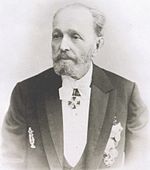- Cinderella (Fitinhof-Schell)
-
Important Ballets & *Revivals of Marius Petipa *Paquita (1847, *1881)
*Le Corsaire (1858, 1863, 1868, 1885, 1899)
The Pharaoh's Daughter (1862, *1885, *1898)
Le Roi Candaule (1868, *1891, *1903)
Don Quixote (1869, *1871)
La Bayadère (1877, *1900)
*Giselle (1884, 1899, 1903)
*Coppélia (1884)
*La fille mal gardée (1885)
*La Esmeralda (1886, 1899)
The Talisman (1889)
The Sleeping Beauty (1890)
The Nutcracker (1892)
Cinderella (1893)
The Awakening of Flora (1894)
*Swan Lake (1895)
*The Little Humpbacked Horse (1895)
Raymonda (1898)
The Seasons (1900)
Harlequinade (1900)Cinderella (AKA Zolushka) - ballet-féerie in 3 Acts, with choreography by Enrico Cecchetti (Act I and Act III) and Lev Ivanov (Act II), with the production being supervised under the counsel and instruction of Marius Petipa. Music by Baron Boris Vietinghoff-Scheel. Libretto by Lydia Pashkova and Ivan Vsevolozhsky.
First presented by the Imperial Ballet on 17 December [O.S. 5 December] 1893 at the Imperial Mariinsky Theatre in St. Petersburg, Russia Empire. Principal Dancers: Pierina Legnani (as Cinderella), Pavel Gerdt (as Prince Charming), Anna Johansson (as the Fairy Godmother/Good Fairy), Mathilde Kschessinskaya (as Odette, the stepsister), Maria Anderson (as Aloisa, the stepsister), Claudia Kulichevskaya (soloist in the Grand Pas d'action of Act II), Nikolai Aistov (as the King), and Alexei Bulgakov (as the Chamberlain).
Revivals
- Revival by Lev Ivanov for the Ballet of the Moscow Imperial Bolshoi Theatre. First presented on 31 July [O.S. 19 July] 1898.
- Revival of Act II by Lev Ivanov for the Imperial Ballet, and especially for the farewell benefit performance of Pierina Legnani. First presented on 5 February [O.S. 23 January] 1900 at the Imperial Mariinsky Theatre.
Notes
- The famous variation in polka rhythm danced in the Mariinsky Theatre version of the Le Corsaire Pas de Deux is taken from Fitinhof-Schell's score for Cinderella.
- Although the scenario of this work was greatly criticised by the St. Petersburg critics balletomanes for putting more emphasis on spectacle and dancing than on drama and story-telling, the production was still an enormous success, particularly with the début of the Italian Ballerina Pierina Legnani, who according to one critic " ... swept all before her ... ". The most celebrated scene was the Ball in the Prince's castle in the second act, which included an elaborate Grand Pas d'action in the 19th century style for the characters Cinderella, the Prince, soloists, and the corps de ballet.
- The premiere of this work in 1893 has the distinction of being the first performance of a ballet to ever have a ballerina perform 32 fouettés en tournant—performed by Pierina Legnani who danced the title role. The ballet historian Konstantin Skalkovsky, dance critic for the St. Petersburg Gazette during the latter half of the 19th century and early 20th century, reported on Legnani's feat: " ... in the last act Legnani positively outdid herself. When Emma Bessone danced the lead in "The Haarlem Tulip" she did 14 fouettés. In her variation Legnani performed 32 of them without stopping, and without travelling one inch! The public delightedly applauded the Ballerina and compelled her to repeat this variation as well. On the repetition she nevertheless did 28 fouettés. To count them became the favourite occupation of the public."
Gallery
1847–59 *Paquita (1847) · *Le Diable amoureux (as "Satanella") (1848) · Leda, the Swiss Milkmaid (1849) · *Giselle (1850, 1884, 1899, 1903) · The Star of Granada (1855) · The Rose, the Violet, and the Butterfly (1857) · *Le Corsaire (1858, 1863, 1868, 1885, 1899) · A Marriage During the Regency (1858) · The Parisian Market (1859, *1861)
1860–79 The Blue Dahlia (1860) · Terpsichore (1861) · The Pharaoh's Daughter (1862, *1885, *1898) · The Beauty of Lebanon (1863) · *The Traveling Dancer (1864) · Florida (1866) · Titania (1866) · *Faust (1867) · The Benevolent Cupid (1868) · The Slave (1868) · Le Roi Candaule (1868, *1891, *1903) · Don Quixote (1869, *1871) · Trilby (1870) · *Catarina (1870) · The Two Stars (1871) · *La Péri (1872) · Camargo (1872) · *Le Papillon (1874) · *Ondine (as "The Naiad and the Fisherman") (1874) · The Bandits (1875) · The Adventures of Peleus (1876, *1897) · A Midsummer Night's Dream (1876) · La Bayadère (1877, *1900) · Roxana (1878) · Ariadne (1878) · The Daughter of the Snows (1879) · Frizak the Barber (1879) · Mlada (1879, *1896)
1880–99 *La Fille du Danube (1880) · Zoraiya (1881) · La Vivandière (as "Markitenka") (1881) · *Pâquerette (1882) · The Night and the Day (1883) · Pygmalion (1883) · *Coppélia (1884) · *Le Diable à Quatre (as "The Willful Wife") (1885) · *La Fille Mal Gardée (1885) · The Magic Pills (1886) · The King's Command (1886, *1887, *1900) · *La Esmeralda (1886) · The Sacrifices to Cupid (1886) · *Fiametta (1887) · The Vestal (1888) · The Talisman (1889) · The Caprices of a Butterfly (1889, *1895) · The Sleeping Beauty (1890) · Nénuphar (1890) · Kalkabrino (1891) · A Fairy Tale (1891) · *La Sylphide (1892) · The Nutcracker (1892) · Cinderella (1893) · The Awakening of Flora (1894) · Swan Lake (1895) · The Little Humpbacked Horse (as "The Tsar Maiden") (1895) · The Calvary Halt (1896) · The Pearl (1896) · Bluebeard (1896) · Raymonda (1898)
1900–03 Les Ruses d'amour (1900) · The Seasons (1900) · Harlequinade (1900) · The Heart of the Marquis (1902) · The Magic Mirror (1903) · The Romance of the Rosebud and the Butterfly (never presented)
Categories:- Ballets by Marius Petipa
- Russian ballet
- Ballets by Enrico Cecchetti
- 1893 ballet premieres
- Cinderella adaptations
Wikimedia Foundation. 2010.





